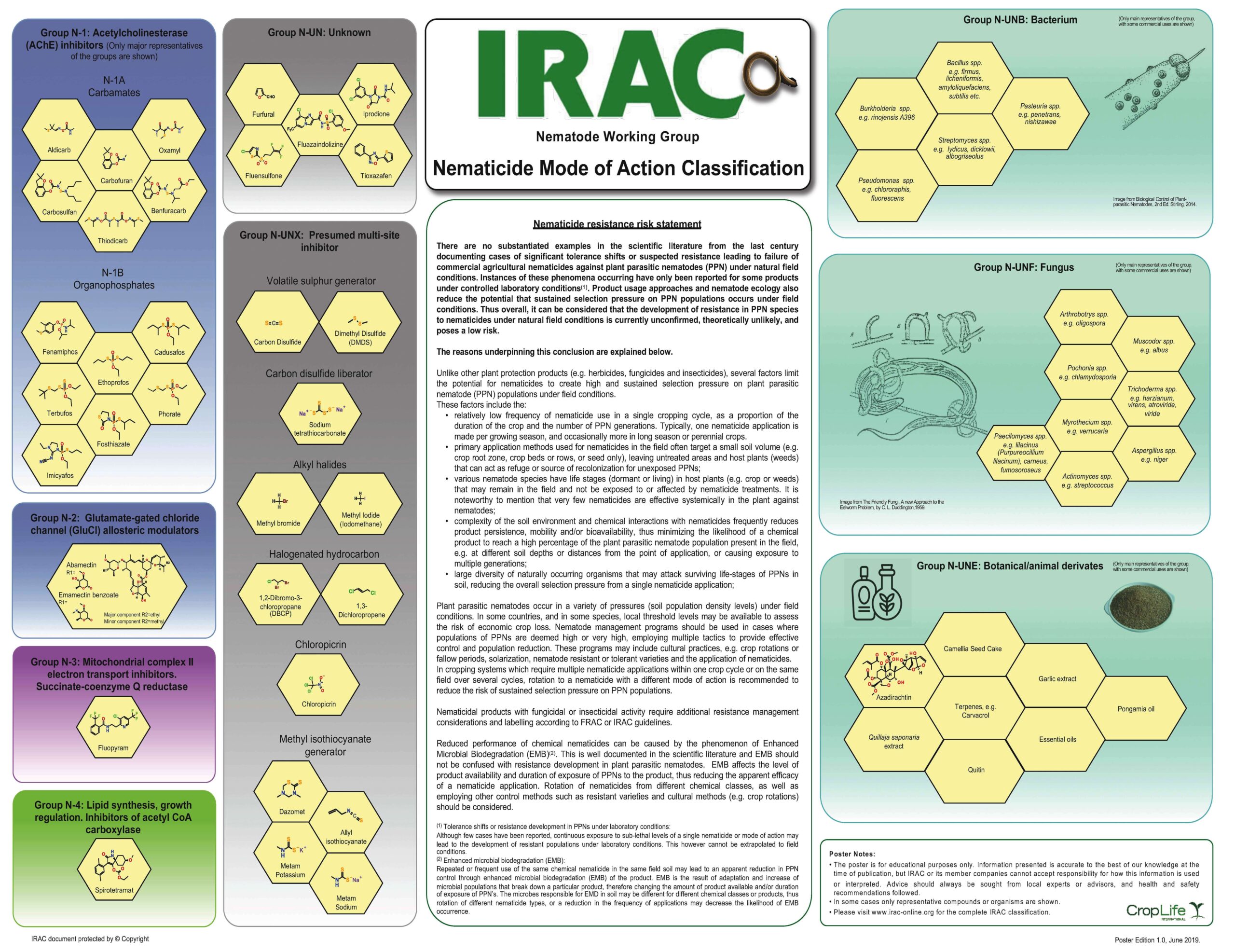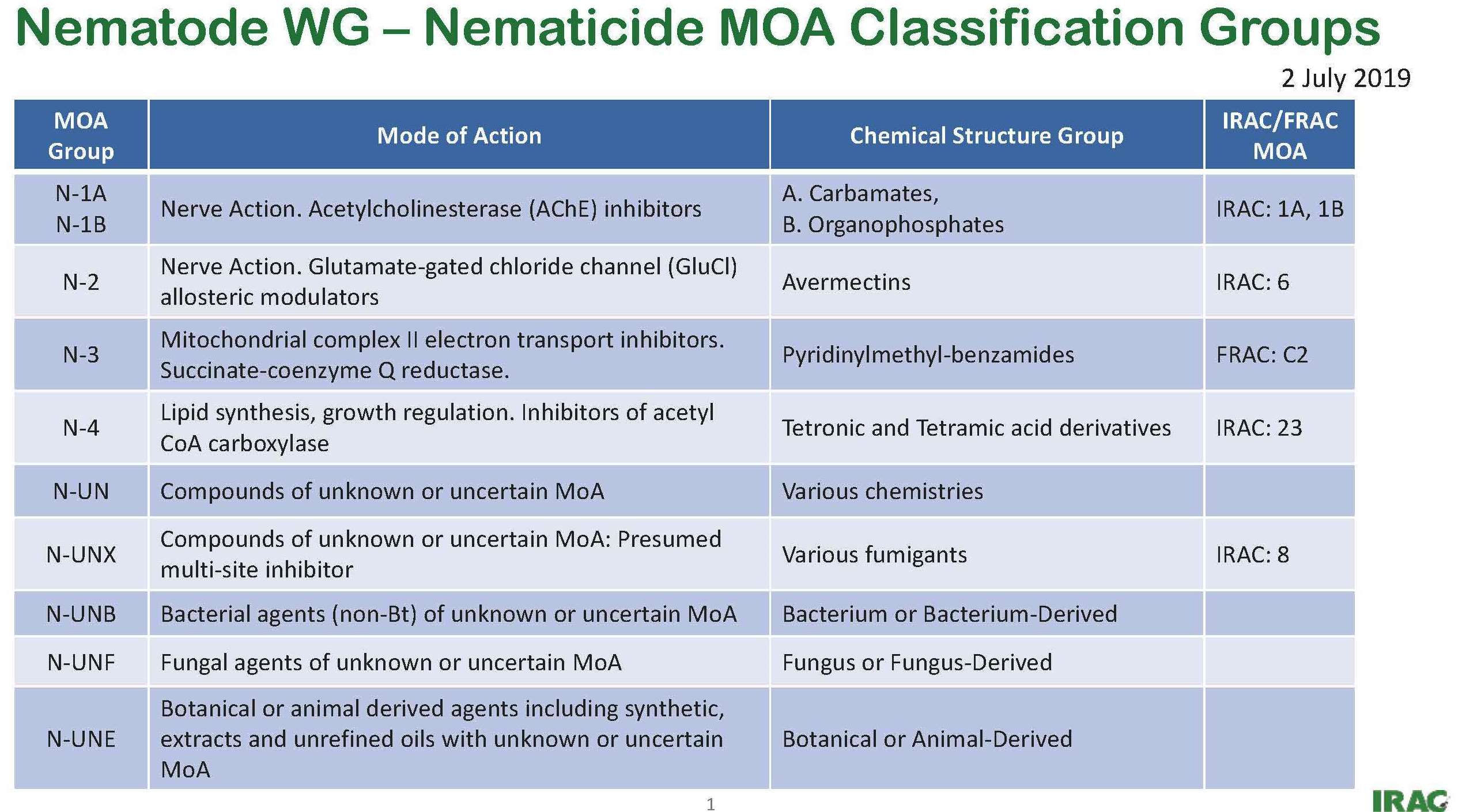IRAC-Nematicide – Mode of Action (MOA) Classification Poster
Nematicides are class of chemicals or biologicals, which kill nematodes (microscopic, worm-like organisms that feed on plant roots). It’s used to protect plants or plant products against all harmful organisms nematodes.
Although no substantiated examples of nematicide resistance resulting in failure of commercial nematicides in agriculture have been documented in the past 100 years, under intense laboratory selection reduced susceptibility to nematicides has been demonstrated.
Thus, as a proactive informational measure, the nematicide MoA Classification has been developed to provide manufactures, regulatory agencies, and other organizations with an MoA reference point for nematicides.
IRAC Mode of Action classification for Nematodes listing the Nematicide Groups Numbers, Mode of action type, and Chemical Groups.
IRAC Mode of Action Classification Scheme published in March 2020, doesn’t cover selective nematicides in the classification.

Nematicide MoA Poster 04 July 2019
IRAC has recently added an entirely new MoA classification specifically addressing nematicides.
In 2019 IRAC published a nematicide MoA Classification poster, which incorporates a wide range of active ingredients including conventional nematicides, fumigants, and biologics known as classical Nematicides. Colour code for nematicide poster; blue – nerve and muscle (i.e. carbamates, OPs, and avermectins), magenta – pyridinylmethyl benzamides, green – tetronic and tetramic acid derivatives, gray – Unknown, aqua – biologicals.

Nematicide MoA Classification,02 July 2019
Conventional nematicides are as follows:
-
-
- Carbamate (Group N-1A),
- Organophosphate (Group N1B) compounds,
- Avermectins (abamectin, Group N-2),
- Pyridinylmethyl benzamides (fluopyram, Group N-3),
- Tetramic acids (spirotetramat, Group N-4)
- The group of compounds (Group N-UN) with unknown MoAs, and
- The group of fumigants (Group N-UNX).
-
Table 1: IRAC Mode of action classification for nematicides.
| Nema Group | Chemical subgroup / exemplifying active | Primary site of action / MoA | Representative a | IRAC/FRAC Group b |
| AI / biologic | ||||
| N-1 | N-1A Carbamates | AChE inhibitors | Oxamyl | IRAC 1A |
| N-1B Organophosphates | AChE inhibitors | Fosthiazate | IRAC 1B | |
| N-2 | Avermectins | Glu-Cl allosteric modulators | Abamectin | IRAC 6 |
| N-3 | Pyridinylmethyl-benzamides | MET II inhibitors | Fluopyram | FRAC 22 |
| N-4 | Tetramic acids | Inhibitors of ACCase | Spirotetramat | IRAC 23 |
| N-UN | imidazopyridine | Unknown | Fluazaindolizine | – |
| Heterocyclic fluoroalkenyl sulfone | Unknown | Fluensulfone | – | |
| Cyclic aldehyde | Unknown | Furfural | – | |
| Dicarboximide | Unknown | Ipodione | – | |
| Disubstituted oxadiazole | Unknown | Tioxazafen | – | |
| N-UNX | Volatile sulfur generator | Unknown, multi-site | Carbon disulfide | – |
| Carbon disulfide liberator | Unknown, multi-site | Sodium tetrathiocarbonate | – | |
| Alkyl halides | Unknown, multi-site | Methyl bromide | IRAC 8A | |
| Halogenated hydrocarbon | Unknown, multi-site | 1,3-dichlorpropene | IRAC 8A | |
| chloropicrin | Unknown, multi-site | Chloropicrin | IRAC 8B | |
| Methyl isothiocyanate generator | Unknown, multi-site | Diazomet | IRAC 8F | |
| N-UNB | Biological – bacterium | Unknown, bacterial action | Bacillus firmus I-1582 | |
| N-UNF | Biological – fungus | Unknown, fungus | Purpureocillium lilacinum | |
| N-UNE | Biological | Unknown, botanical / plant origin | Pongamia oil | – |
| Biological – tetranortriterpines | Unknown, botanical / plant origin | Azadiractin | IRAC UN | |
| Biological – saponins from Quillaja saponaria tree | Unknown, botanical / plant origin | Quillaja saponaria extract | – | |
| Biological – essential oil | Unknown, botanical / plant origin | Carvacrol | IRAC UNE |
a Representative compound / active within an IRAC grouping.
b Equivalent IRAC or FRAC grouping.
Nematicides (Unidentified MoAs):
Among these recent nematicides with as yet unidentified MoAs are tioxazafen (South et al., 2019), fluazaindolizine (Lahm et al., 2019), and fluensulfone (Maienfisch et al., 2019).
The recent development of biologics for plant-parasitic nematode control (Maienfisch et al., 2019) provides added options for growers.
The biologics for nematode control have been divided into three Groups; bacteria (N-UNB), fungi (N-UNF), and botanical / animal derivatives, and extracts (N-UNE).
The present update reflects the new addition of a Nematicide MoA Classification also recognizes the growing interest and focus on new compounds for nematode control, and as tools for integrated nematode management.
About IRAC Nematode Group:
The IRAC Nematode Working Group is the most recently established IRAC team. The initial objectives of the team will be to investigate the resistance risk of nematicides and to develop a mode of action classification scheme similar to that available for insecticides and acaricides.
There is clear evidence that nematicide resistance can occur under laboratory conditions, but it is less clear if field resistance can occur under natural conditions. There is however some evidence to show that increased degradation of nematicides and other pesticides can occur through increased microbial activity in the soil (not classical resistance, but with similar impact). Enhanced pesticide metabolism in soil, tends to be chemical class-specific, which means nematicide/insecticide rotation or reduction in application intervals can slow its occurrence.
Resistance risk can vary significantly between crops, with row crops being considered low risk (low number of applications), whilst others receive multiple applications per year/season (e.g. banana, vegetables).
For More details: Subscribe AgroPat* (http://chemrobotics.com/)
-
AgroPat provides techno-legal solutions to Agrochemical Discovery and Generic industry. (https://www.chemrobotics.com/agropat-lighter/login)
-
AgroPat platforms cover more than 4500 Active Ingredients (Al’s) with all information including synthesis (ROS), formulation, combination, innovator, patents including product patent, developer, utmost important biology data containing spectrum, MoA, DFU, toxicity, which can play a major role in decision making for any individual /company/ university/ industry.
-
-
- AgroPat Open Access – Free access to everyone,
- AgroPat Lite – With limited information as per business function needs,
- AgroPat ultimate – With all technical and business information,
-
-
-
Provide aboriginal information, which enables product developers to know about the state of the art in relevant subject matter, which includes innovator Patent / Non-Patent literature, which is critical for the generic industry.
-
Indian Pesticide Database (IPD) offers pesticide product registration/approval Information in various categories including Section 9(3), Section 9(3B), Section 9(4) and Bio-pesticides (https://www.chemrobotics.com/agropat/#/ipd)
-
“Global Agro Product Directory” is an Agrochemical product directory, wherein all approved agrochemical products can be tracked. (https://www.chemrobotics.com/pesticides-directory/)
-
MRL database has the maximum residue limits (MRLs) allowed for most pesticides used on major fruit and vegetable export crops and commodities in different counties like the USA, Europe, Japan, Canada, China, India, Australia, Israel, Malaysia, and Taiwan. Exporters can use this database to find out the residue limits in global markets. (https://www.chemrobotics.com/agropat/#/mrldir)
-
“Brazil-Ag-Pedia” is a Brazil Agrochemical product directory, wherein all approved agrochemical products in Brazil can be tracked with all relevant information (https://www.chemrobotics.com/agropat/#/brazil_ag_pedia)


